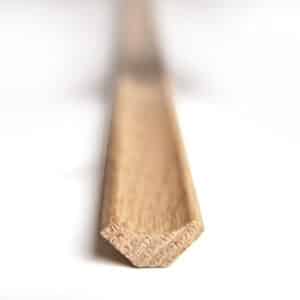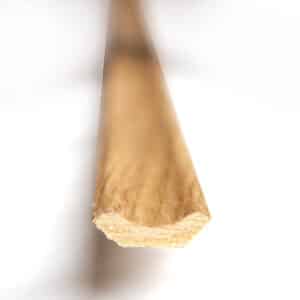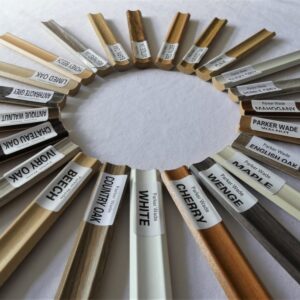Premium suppliers of quality engineered wood flooring for THE FLOORING TRADE
Guaranteed warranty on all products
Scotia
Exploring the Benefits of MDF Scotia
MDF Scotia, also known as MDF (Medium Density Fiberboard) Scotia, is a type of molding or trim used in interior finishing and carpentry. MDF is a composite wood product made from wood fibers and resin, which are compressed and bonded together under high pressure and heat. The result is a dense and uniform board that is smooth on both sides.
Scotia molding is a specific type of quarter-round moulding with a concave profile, typically used to cover the gap between the bottom of the baseboard and the floor. It is commonly used to create a finished and visually appealing transition between the baseboard and the floor surface, especially in laminate or hardwood flooring installations. The molding can also be used in other applications, such as concealing gaps between cabinets and walls.
MDF Scotia is popular because it is relatively inexpensive, easy to work with, and provides a smooth surface for painting or finishing. However, it is important to note that MDF is susceptible to moisture damage, so it should not be used in areas with high humidity or potential exposure to water. In such cases, alternative materials like solid wood or PVC-based moldings may be more appropriate.
What is scotia used for?
Scotia is a type of molding or trim used in interior finishing and carpentry. Its primary purpose is to create a finished and visually appealing transition between different surfaces or materials.
Here are some common uses for scotia molding:
Flooring
Scotia is often used to cover the gap between the bottom of the baseboard and the floor surface. This helps conceal any uneven edges or expansion gaps that may occur between the flooring and the wall.
Baseboards
In some cases, scotia can be used as an alternative to larger baseboards, especially in situations where space is limited or a more subtle design is desired.
Cabinets
Scotia can be used to cover the gap between cabinets and walls, providing a neat and cohesive appearance in kitchen and bathroom installations.
Stairs
Scotia can be installed along the bottom edge of stair treads to give them a finished look and to cover any gaps between the stairs and the wall.
Wall paneling
When wall panels or wainscoting are used, scotia can be employed at the top or bottom of the panels to provide a smooth and attractive transition to the adjacent surfaces.
Window sills
Scotia can be used to trim the edges of window sills, providing a decorative element and helping to hide any imperfections.
The Versatility of Scotia Molding: Exploring Materials, Budgets, and Aesthetics
Scotia molding comes in various materials, including wood, MDF, PVC, and other synthetic materials. The choice of material will depend on factors such as budget, desired aesthetics, and the environment where it will be installed (e.g., moisture-prone areas like bathrooms may require waterproof materials). Overall, scotia serves both functional and decorative purposes, enhancing the overall look and feel of interior spaces.
Benefits of laminate scotia:
Laminate scotia, which is made of laminate material, offers several benefits when used in interior finishing and carpentry projects.
Here are some of the advantages of using laminate scotia:
Cost-Effective
Laminate scotia is generally more affordable compared to solid wood or other premium materials. This makes it an economical choice for those on a budget or for large-scale projects.
Wide Range of Designs
Laminate scotia comes in a variety of designs, patterns, and colors. It can mimic the appearance of real wood, stone, or other materials, providing a diverse selection to match different interior design styles.
Durability
Laminate scotia is resistant to wear, scratches, and dents, making it a durable choice for high-traffic areas. It can withstand daily wear and tear, maintaining its appearance over time.
Moisture Resistance
Laminate scotia has a protective layer that makes it more resistant to moisture and humidity than some other materials like MDF. This makes it suitable for use in bathrooms, kitchens, and other potentially damp areas.
Easy to Clean
Laminate scotia is easy to clean with a damp cloth or mild cleaning solution. Its smooth surface does not absorb spills or stains, making maintenance hassle-free.
Easy Installation
Installing laminate scotia is relatively simple and does not require specialized tools or skills. It can be easily cut and installed using basic carpentry tools.

Consistent Quality
Laminate scotia is manufactured under controlled conditions, ensuring consistent quality and appearance across all pieces. This predictability can be advantageous for achieving a uniform look in the room.
Eco-Friendly Options
Some laminate scotia products are made from sustainable materials or have eco-friendly certifications, making them a greener choice for environmentally conscious consumers.
Stain and Fade Resistance
Laminate scotia is less prone to staining and fading when exposed to sunlight, ensuring that it maintains its appearance over time.
Versatility
Laminate scotia can be used in various applications, including covering gaps between baseboards and floors, concealing edges of laminated or hardwood flooring, and adding finishing touches to cabinetry.
Despite these advantages, it’s important to note that laminate scotia may not have the same visual and tactile appeal as solid wood or other premium materials. Additionally, it can be less forgiving to repair if it gets damaged, as replacing a damaged section may require removing and reinstalling the entire piece. Overall, the choice of scotia material will depend on your specific needs, budget, and the overall design vision for the space.
Benefits of using scotia in a room
Using scotia in a room can offer several benefits, both functional and aesthetic.
Here are some of the advantages of incorporating scotia molding in interior spaces:
Reduces Dust Accumulation
Scotia helps reduce the accumulation of dust and debris in gaps and crevices, making it easier to maintain a clean and hygienic living environment.
Conceals Wiring and Cables
In some cases, scotia can be used to hide wires or cables running along the base of walls, contributing to a tidier and more organized space.
Aesthetics
Scotia adds a finishing touch to a room, creating a polished and cohesive look. It covers gaps and transitions between different surfaces, giving the space a neat and visually appealing appearance.
Hides Imperfections
Scotia can conceal any gaps or uneven edges that may occur between the floor and baseboard or between wall panels and surfaces, hiding imperfections in the installation.
Protects Edges
It helps protect the edges of flooring, baseboards, stairs, and other surfaces from wear and tear, reducing the likelihood of damage or chipping over time.
Smooth Transitions
Scotia provides a smooth and seamless transition between various materials, such as between the floor and the baseboard or between different wall surfaces.
Enhanced Durability
By covering gaps and exposed edges, scotia can extend the lifespan of the materials it protects, preventing them from getting damaged or worn out prematurely.
Versatility
Scotia comes in various sizes, styles, and materials, making it versatile and suitable for different interior design styles and room configurations.
Easy Installation
Installing scotia is relatively straightforward and can be done using nails or adhesive, making it a cost-effective way to improve the appearance of a room.
Options for Customization
Scotia can be painted or stained to match the color scheme of the room, allowing for customization and design flexibility.
Overall, scotia molding serves both practical and decorative purposes, enhancing the overall aesthetics and functionality of interior spaces, while also protecting and preserving various surfaces within the room.
Matching Scotia Trims
Matching scotia finishes refers to ensuring that the scotia molding used in a room complements or matches the existing finishes or design elements in the space. This is done to create a cohesive and harmonious look, where the scotia seamlessly blends with the rest of the room’s décor.
Here are some tips on how to achieve matching scotia finishes:
Colour Matching
Pay attention to the colour scheme of the room. Choose scotia molding that either matches the color of the baseboards or the flooring, depending on where it will be installed. If the room has a particular dominant color, select scotia with a similar or complementary hue.
Material Choice
Select a scotia material that complements other finishes in the room. For example, if the room features a lot of natural wood elements, consider using wood scotia to maintain consistency. Similarly, if the room has a more modern or minimalist design, opt for sleek and simple scotia profiles.
Finish Type
The finish of the scotia can affect its appearance. For example, you may choose a glossy finish for a more contemporary look, while a matte finish can provide a more subdued and traditional feel.
Profile Style
Consider the style of the scotia profile. Some scotia moldings have more intricate designs, while others are simpler in their appearance. Choose a profile that complements the overall design aesthetic of the room.
Texture
If the room features textured elements, such as textured wallpaper or textured flooring, take that into account when choosing the scotia. A smooth scotia might not match well with heavily textured surfaces, so consider opting for a textured scotia or one with subtle surface details.
Consistency Throughout the Space
Aim for consistency when using scotia throughout the room. Use the same type of scotia in areas where it’s needed, like along the baseboards, and maintain the same finish and color to create a unified look.
Colour Matching
Pay attention to the colour scheme of the room. Choose scotia molding that either matches the color of the baseboards or the flooring, depending on where it will be installed. If the room has a particular dominant color, select scotia with a similar or complementary hue.
Test Samples
Before making a final decision, obtain small samples of the scotia options you are considering. Place them against the existing finishes in the room to see how well they match. This can help you make an informed choice.
FREE DELIVERY:
ACCESSORIES OVER £200 & LAMINATE / LVT ORDERS OVER £1500, PLACED BEFORE 3.00 PM
GET IN TOUCH
Have an idea or project then please get in touch...




